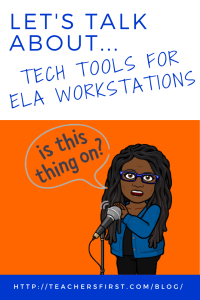After seeing all of the Read Across America posts this past week, I decided to focus my post this month on reading. I want to share some ideas on using technology to support reading instruction in ways that follow strategies and the science of reading framework.
The science of reading framework includes the latest research on how the brain learns to read. It emphasizes the importance of teaching foundational reading skills, such as phonemic awareness, phonics, fluency, vocabulary, and comprehension. It also recognizes the role of motivation, engagement, and background knowledge in reading development.
One of the challenges of teaching reading is to provide students with enough practice and feedback on these skills, especially when they have different proficiency levels and needs. That’s why I wanted to look at ways for students to practice language structures independently at classroom workstations.
I’ve looked around the digital landscape and found five strategies that will be helpful for most students working in this way. Let’s take a look at them.
1. Unjumble Sentences with Wordwall.net
First, let me introduce you to Wordwall.net (reviewed here), a website that enables you to create interactive games and activities for your students. You can use the site’s templates or create your own from scratch. You can also browse and use the materials created by other educators who share them with the community group.
One of the templates that I really like is Unjumble. It’s a great game that challenges students to arrange the words in a sentence correctly. Students can practice syntax at a workstation set up with an unjumble activity. You can customize the sentences to match your curriculum and objectives. For example, you can use sentences that contain sight words, irregular verbs, complex clauses, or specific vocabulary.
This activity is a fantastic way to challenge students to flex their syntactic muscles. Picture this: students huddled around a workstation, feverishly rearranging words to form coherent sentences. It’s engaging, it’s interactive, and most importantly, it’s effective.
2. Practice Morphology with Wordwall.net
If you want your students to practice morphology, Wordwall is a great place to start. Morphology studies the formation of words and how they change meaning and function. For example, adding the suffix -ed to a verb changes it to the past tense, and adding the prefix un- to an adjective changes it to the opposite meaning.
Morphology is vital for reading because it helps students decode unfamiliar words, expand their vocabulary, and understand language structure. One of the things I love about this platform is the sense of community. Educators who use Wordwall share their materials, making it a treasure trove of resources tagged by the content area. You can find ready-made activities tagged as Latin roots, greek roots, prefixes, suffixes, or compound words. Or you might find an educator whose activities match your instructional objectives.
Here is an example of a Wordwall activity I found for practicing prefixes.
3. Building Bases Board by Wordtorque
Another excellent tool for practicing morphology is the Building Bases Board by Wordtorque. This virtual board has tiles representing different word parts, such as bases, prefixes, suffixes, and inflectional endings. You can use this board to teach students how to break down words into their components and build new words by combining them.
I would have students use this tool in pairs, taking turns to map out words on their list. They can also challenge each other to create new words or find synonyms or antonyms for their mapped words. This activity helps students develop their word awareness, spelling, and vocabulary skills. It’s a dynamic way to deepen their understanding of language roots and affixes while fostering teamwork and communication skills.
4. Practice Grammar with No Red Ink and Khan Academy
Grammar is another essential component of reading instruction. It helps students understand the meaning and structure of sentences. Grammar also helps students improve their writing skills as they learn how to use punctuation, capitalization, and sentence variety.
Many online tools can help students practice grammar skills, but No Red Ink (reviewed here) and Khan Academy (reviewed here) are two of my favorites. No Red Ink is a tool for grammar practice exercises that adapts to the student’s level and interests. It also provides instant feedback and explanations for the students. Khan Academy goes one step further by providing instruction before giving students activities to practice. It also covers parts of speech, clauses, phrases, and sentence types.
5. Empowering Instruction with Technology
These suggestions give you some ideas for using technology to support your instruction as you adopt practices supported by the science of reading framework. By incorporating these tech tools into our classrooms, we embrace innovation and empower our students to become confident, independent learners.
What are your favorite tech tools for supporting reading instruction? I would love to hear from you about how you use these tools or any other tools that you find helpful for teaching reading. Share your thoughts and experiences in the comments below. Let’s keep the conversation going!



Iḿ intrigued by these and cant wait to dive into these a little deeper to see if they will fit my 5th grade classroom. My coteacher and I know we need to focus more on vocabulary than weekly spelling but want to do it in a way that is engaging and current for our CT class. These workstations may be a great fir for our What I Need time during the day, where we are able to work with smaller groups and tailor instruction to students needs.
I am always trying to find more engaging resources during ELA centers that focus on word work and vocabulary. The resources in your blog would be great for my students and I cannot wait to incorporate them within my classroom